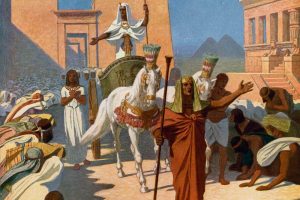Big Feelings in a Small Letter
“Big” Feelings in a “Small” Letter

Shalom,
In the Hebrew alphabet there are no capital or small letters. All the letters are supposed to be equal.

However, according to the tradition, there are 17 places in the Bible where Hebrew the letters are extra-large or extra-small.
The scribal terminology is:
majuscule and miniscule.
In Hebrew the small letters are called – אותיות זעירות (OTIYOT ZE’IROT).
The big letters are called – אותיות רבתי (OTIYOT RABATI).
Let’s say that in the terminology of modern typography, if the scribe wrote the rest of the Torah in 12 points, the majuscule letters would be in 16 point, while the miniscule letters would be in 8 points.
There are various explanations to the reason of the different size of those letters, some of them allude to the mysterious and mystical aspect of the words and verses in which these letters appear.
According to the tradition, there are altogether six miniscule letters and eleven majuscule letters.
For example, the first letter in the Torah, the first letter beth in the word Bereshit, is a majuscule).
בְּרֵאשִׁית, בָּרָא אֱלֹהִים, אֵת הַשָּׁמַיִם, וְאֵת הָאָרֶץ
In the beginning God created the heaven and the earth
The most famous majuscules are certainly the final letters of the first and last words of the famous verse “She’ma Yisrael…” – those are larger than all the others in the Torah scroll. (Devarim – Deuteronomy 6:4)
שְׁמַע, יִשְׂרָאֵל: יְהוָה אֱלֹהֵינוּ, יְהוָה אֶחָד
Hear, O Israel: the LORD our God, the LORD is one
In this case, the letters are large to avoid confusion: a large ayin in the word ‘She’ma’ to avoid confusion with aleph: ‘perhaps O Israel.’
Hear = שמע
Perhaps = שמא
The large dalet to avoid confusion with reish:
‘the Lord is another’.
One = אחד
Another = אחר
One of the many explanations for that is that we enlarge those letters to ensure that they are read properly.
If the word shema, שמע, would be read with an aleph—which sounds very similar to the ayin—the meaning of the word would change from “hear” to “maybe,” changing a firm declaration of belief into an expression of doubt.
Similarly, if the ד (dalet) of the word echad, אחד, would be mistaken for a ר (reish)—as the two look almost identical—then echad(“one”) would be read acher (“other”).
This would make our belief in one G‑d look like a belief in two gods.
In the book of Leviticus, in the first verse the word Vayikra,
“God Called (to Moses)” ends with a with an aleph zeira – a tiny or subscript aleph.
וַיִּקְרָא, אֶל-מֹשֶׁה; וַיְדַבֵּר יְהוָה אֵלָיו, מֵאֹהֶל מוֹעֵד לֵאמֹר
Vayikra el Moshe vayidaber Adonai eilav.” (God called to Moses and spoke to him…)
Another instance of a miniscule letter is in this week’s Torah portion “Chayey Sarah”.
וַתָּמָת שָׂרָה, בְּקִרְיַת אַרְבַּע הִוא חֶבְרוֹן–בְּאֶרֶץ כְּנָעַן; וַיָּבֹא, אַבְרָהָם, לִסְפֹּד לְשָׂרָה, וְלִבְכֹּתָהּ
And Sarah died in Kiriatharba–the same is Hebron–in the land of Canaan; and Abraham came to mourn for Sarah, and to weep for her. (Gen. 23:2)
Notice the small letter כּ in the word וְלִבְכֹּתָהּ (VE’LIVKOTAH) to weep for her.

One of the explanations that is given by the commentator Ba’al Haturim is that Avraham did not cry much after the death of his wife Sarah. He just wept a little… Therefore, the letter כּ is “little”, to express that.
And this is quite strange to assume that Avraham spent just little time to weep after his wife’s death.
After all, for instance, we know from the Torah that there was a 70-day mourning in Egypt after Josephs death, and people of Israel were in grief for 30 days after the death of Moses.
Also, usually people first cry after a death of a close person, and only then they mourn.
Abraham first mourns and then weeps.
One of the explanations this is that in the case of Sarah’s death, since she was a very known public figure in her times, it was very important for Avraham to publicly eulogize Sarah in front of the big audience that gathered in Hebron.
This is expressed in the mourning לִסְפֹּד לְשָׂרָה
which precedes the crying.
The eulogy was a demonstrative public act for the public figure of Sarah, while weeping was Avraham’s very personal, deep and intimate act to express his feelings, which in the lieu of the circumstances, he kept very short, as the Torah shows us by expressing it with the small letter כּ
Shabbat Shalom,

Orly & Yoel
You can find our previous posts at:
https://www.ulpanor.com/category/newletter/





